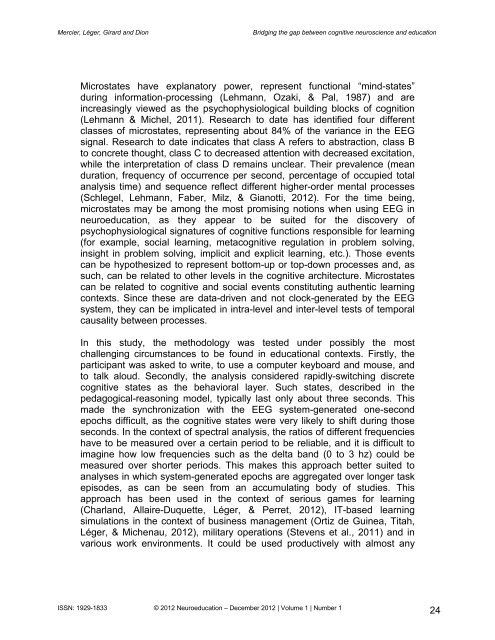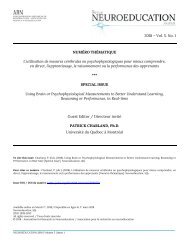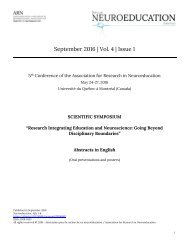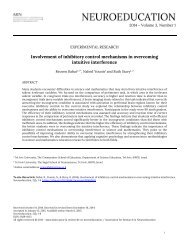Neuroeducation_2012_vol-1_no-1_full
Neuroeducation journal - Volume 1, Issue 1 (2012) - 144 pages
Neuroeducation journal - Volume 1, Issue 1 (2012) - 144 pages
You also want an ePaper? Increase the reach of your titles
YUMPU automatically turns print PDFs into web optimized ePapers that Google loves.
Mercier, Léger, Girard and Dion<br />
Bridging the gap between cognitive neuroscience and education<br />
Microstates have explanatory power, represent functional “mind-states”<br />
during information-processing (Lehmann, Ozaki, & Pal, 1987) and are<br />
increasingly viewed as the psychophysiological building blocks of cognition<br />
(Lehmann & Michel, 2011). Research to date has identified four different<br />
classes of microstates, representing about 84% of the variance in the EEG<br />
signal. Research to date indicates that class A refers to abstraction, class B<br />
to concrete thought, class C to decreased attention with decreased excitation,<br />
while the interpretation of class D remains unclear. Their prevalence (mean<br />
duration, frequency of occurrence per second, percentage of occupied total<br />
analysis time) and sequence reflect different higher-order mental processes<br />
(Schlegel, Lehmann, Faber, Milz, & Gia<strong>no</strong>tti, <strong>2012</strong>). For the time being,<br />
microstates may be among the most promising <strong>no</strong>tions when using EEG in<br />
neuroeducation, as they appear to be suited for the discovery of<br />
psychophysiological signatures of cognitive functions responsible for learning<br />
(for example, social learning, metacognitive regulation in problem solving,<br />
insight in problem solving, implicit and explicit learning, etc.). Those events<br />
can be hypothesized to represent bottom-up or top-down processes and, as<br />
such, can be related to other levels in the cognitive architecture. Microstates<br />
can be related to cognitive and social events constituting authentic learning<br />
contexts. Since these are data-driven and <strong>no</strong>t clock-generated by the EEG<br />
system, they can be implicated in intra-level and inter-level tests of temporal<br />
causality between processes.<br />
In this study, the methodology was tested under possibly the most<br />
challenging circumstances to be found in educational contexts. Firstly, the<br />
participant was asked to write, to use a computer keyboard and mouse, and<br />
to talk aloud. Secondly, the analysis considered rapidly-switching discrete<br />
cognitive states as the behavioral layer. Such states, described in the<br />
pedagogical-reasoning model, typically last only about three seconds. This<br />
made the synchronization with the EEG system-generated one-second<br />
epochs difficult, as the cognitive states were very likely to shift during those<br />
seconds. In the context of spectral analysis, the ratios of different frequencies<br />
have to be measured over a certain period to be reliable, and it is difficult to<br />
imagine how low frequencies such as the delta band (0 to 3 hz) could be<br />
measured over shorter periods. This makes this approach better suited to<br />
analyses in which system-generated epochs are aggregated over longer task<br />
episodes, as can be seen from an accumulating body of studies. This<br />
approach has been used in the context of serious games for learning<br />
(Charland, Allaire-Duquette, Léger, & Perret, <strong>2012</strong>), IT-based learning<br />
simulations in the context of business management (Ortiz de Guinea, Titah,<br />
Léger, & Michenau, <strong>2012</strong>), military operations (Stevens et al., 2011) and in<br />
various work environments. It could be used productively with almost any<br />
ISSN: 1929-1833 © <strong>2012</strong> <strong>Neuroeducation</strong> – December <strong>2012</strong> | Volume 1 | Number 1<br />
24








